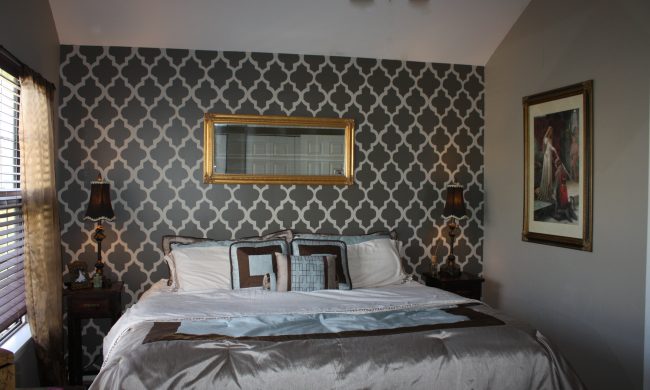
When remodeling the interior of your home, paint and wallpaper often play a role in not only the finished look of your project, but its durability, too. While the right paint or wallpaper choices and applications can keep your interiors looking their best for years to come, shoddy products and improper application techniques can age prematurely, running your otherwise stunning renovations. Using the right wallpaper techniques and knowing the best house painting procedures are excellent first-steps in achieving an interior you not only like, but one that will maintain its appearance over the long haul.
Wallpaper Installation Techniques
Different kinds of wallpaper require different installation techniques. Most newer products are easy to install if you simply follow the manufacturer’s instructions. While these instructions might seem a little tedious or contain steps you’d rather just skip over, it is extremely important to follow each and every one to a T, as failure to do so often leads to poor adhesion and other problems later on.
Vintage wallpaper and some newer specialty wallpaper require the use of a separate adhesive to make the paper stick in place. Since such vintage or specialty wallpaper is often rather costly to begin with, those who choose these products often also opt for professional installation to make sure that their higher-end investment looks and performs its absolute best.
Wallpaper Removal Techniques
While some homeowners are interested in putting wallpaper up, for many others, wallpaper removal techniques are a more useful skill to master. In most cases, wallpaper removal techniques are divided into one of three categories: dry removal, wet scraping, and steam stripping. Unless you’re already well-versed in wallpaper, you probably won’t know until you actually begin removing it which technique is right for you.
The easiest and most straightforward of wallpaper removal techniques is dry removal. If you loosen a corner of the existing paper and can easily and effectively peel it away in its entirety or in very large pieces, you’ve lucked out. Continue pulling the paper away at an angle and soon your wall will be paper-free.
The next wallpaper removal technique is wet scraping or soak and scrape. This requires you to douse the existing wallpaper with water, let it soak in, then peel it away with your fingers or scrape it off with a putty knife. When dealing with non-porous wallpaper, you’ll actually have to rough up its surface before you soak it so that the water can penetrate beneath the surface and loosen the adhesive behind it.
The final common wallpaper removal technique is the steam method. This can generally be used on any type of wallpaper that cannot be removed dry and is actually a bit easier than wet scraping, though it does require renting a steam machine (typically easy to procure from any business that sells wallpaper). This method is particularly useful for wallpaper that has been painted over, but be careful! These machines might seem benign, but when used improperly they can cause personal injury or damage to the wall underneath the paper!
House Painting Procedures
For most homeowners, paint is a more desirable material to work with than wallpaper, both in its application and in its removal. Proper interior house painting procedures are easy for most homeowners to follow, and many first-timers can produce close-to-professional results if they choose the right paint, don’t skimp on the prep-work, and take their time.
Several major distinctions between interior and exterior house painting procedures make the latter a far more difficult job for the average homeowner. While interior paint might be subjected to some damaging factors, the constant exposure to weather, sunlight, and temperature changes outdoor paint must face leaves far less room for mistakes. Additionally, you need to consider the fact that outdoor house painting often necessitates the use of power washers and paint strippers for prep work, professional paint sprayers, scaffolding, and other equipment to be done effectively and efficiently. Though some might have such equipment hanging around in the garage, most of us would have to rent or purchase these items, drastically increasing the cost of the project to the point that it could equal (or even exceed) the cost of hiring a professional.
No matter where you are painting, it is always wise to consult a professional before you begin your project. Some professionals offer extremely affordable booklets outlining their favored house painting procedures in detail; a few even offer lessons. Having the advice of a local professional can help you with everything from paint selection to surface preparation to the tips and touches that separate a professional job from an amateur one. These contractors know which brands of paint tend to hold up best and which equipment is worth purchasing or renting. They may even be able to tell you which colors and trends are becoming popular with new home buyers, so even if you decide to paint your own home, it is well worth the effort it takes to at least discuss your project with a pro!
 Can I Paint Over Wallpaper?
Can I Paint Over Wallpaper?  Wall Painting Techniques
Wall Painting Techniques  How to Paint a Ceiling – Tips & Best Practices
How to Paint a Ceiling – Tips & Best Practices  How to Paint Popcorn & Textured Ceilings
How to Paint Popcorn & Textured Ceilings  Painting vs. Hanging Wallpaper: What Are the Advantages of Each Option?
Painting vs. Hanging Wallpaper: What Are the Advantages of Each Option? 

Are You Familiar With This Topic? Share Your Experience.